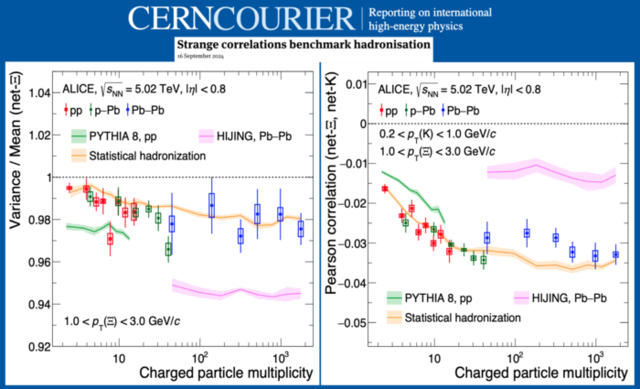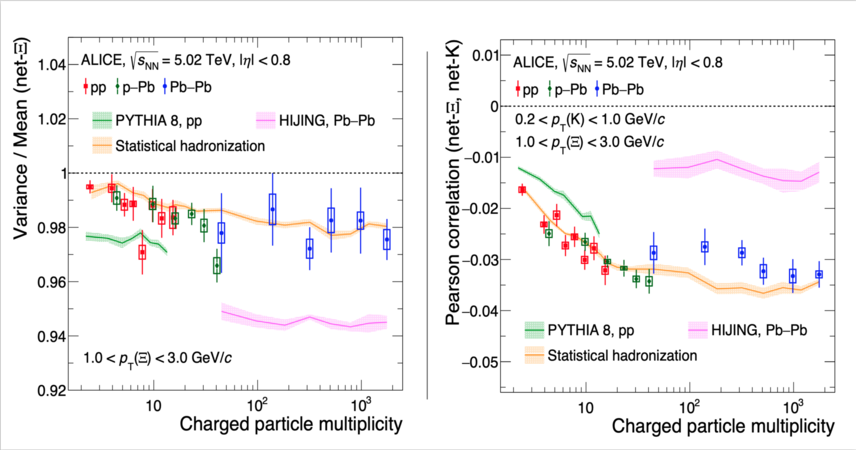
CERN Courier Article (Sep/Oct 2024):
Strange correlations benchmark hadronisation
In high-energy hadronic and heavy-ion collisions, strange quarks are dominantly produced from gluon fusion. In contrast to u and d quarks, they are not present in the colliding particles. Since strangeness is a conserved quantity in QCD, the net number of strange and anti-strange particles must equal zero, making them prime observable to study the dynamics of these collisions. Various experimental results from high-multiplicity pp collisions at the LHC demonstrate striking similarities to Pb–Pb collision results. Notably, the fraction of hadrons carrying one or more strange quarks smoothly increases as a function of particle multiplicity in pp and p–Pb collisions to values consistent with those measured in peripheral Pb–Pb collisions. Multi-particle correlations in pp collisions also closely resemble those in Pb–Pb collisions.
Explaining such observations requires understanding the hadronisation mechanism, which governs how quarks and gluons rearrange into bound states (hadrons). Since there are no first-principle calculations of the hadronisation process available, phenomenological models are used, based on either the Lund string fragmentation (Pythia 8, HIJING) or a statistical approach assuming a system of hadrons and their resonances (HRG) at thermal and chemical equilibrium. Despite having vastly different approaches, both models successfully describe the enhanced production of strange hadrons. This similarity calls for new observables to decisively discriminate between these two approaches.
In a recently published study, the ALICE collaboration measured correlations between particles arising from the conservation of quantum numbers to further distinguish the two models. In the string fragmentation model, the quantum numbers are conserved locally through the creation of quark–antiquark pairs from the breaking of colour strings. This leads to a short-range rapidity correlation between strange and anti-strange hadrons. On the other hand, in the statistical hadronisation approach, quantum numbers are conserved globally over a finite volume, leading to long-range correlations between both strange–strange and strange–anti-strange hadron pairs. Quantum-number conservation leads to correlated particle production that is probed by measuring the yields of charged kaons (with one strange quark) and multistrange baryons (Ξ– and Ξ+) on an event-by-event basis. In ALICE, charged kaons are directly tracked in the detectors, while Ξ baryons are reconstructed via their weak decay to a charged pion and a Λ-baryon, which is itself identified via its weak decay into a proton and a charged pion.

In the figure, the first measurement of the normalized variance of the net number (difference between the particle and antiparticle multiplicities) of Ξ baryons and the correlation between net-Ξ and net-kaon numbers are presented as a function of the average charged-particle multiplicity at midrapidity in pp, p-Pb and Pb-Pb collisions.
The experimental results on the correlations deviate from the uncorrelated baseline (dashed line), and string fragmentation models that mainly correlate strange hadrons with opposite strange quark content over a small rapidity range fail to describe both observables. At the same time, the measurements agree with the statistical hadronisation model description that includes opposite-sign and same-sign strangeness correlations over large rapidity intervals. The data indicate a weaker opposite-sign strangeness correlation than that predicted by string fragmentation, suggesting that the correlation volume for strangeness conservation extends to about three units of rapidity.
The study will be extended using the recently collected data during LHC Run 3. The larger data samples will enable similar measurements for the triply strange Ω baryon and the study of higher cumulants.
Further reading
ALICE Collab. 2024 arxiv.2405.19890
